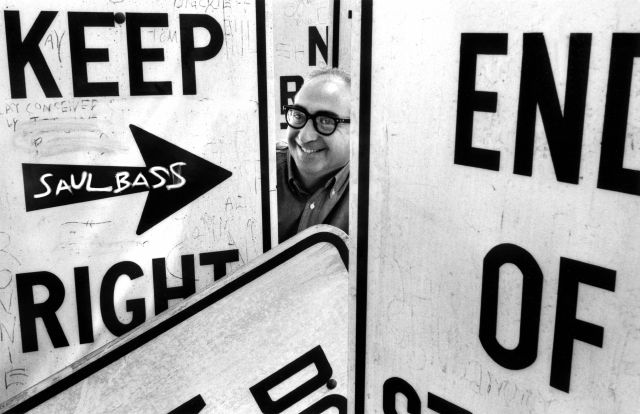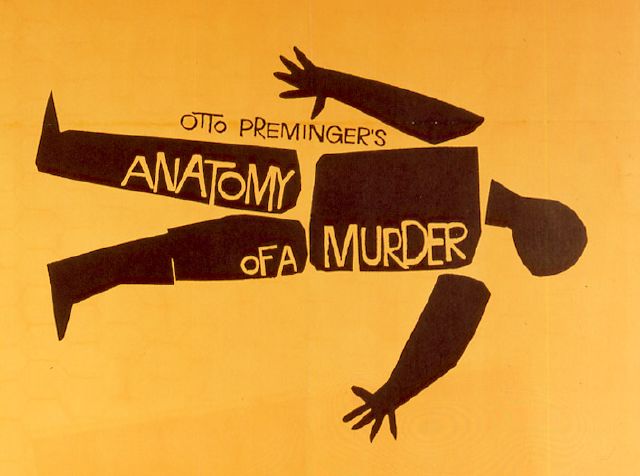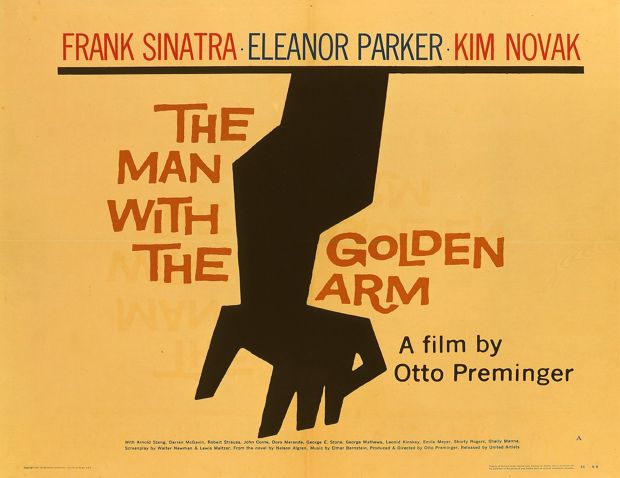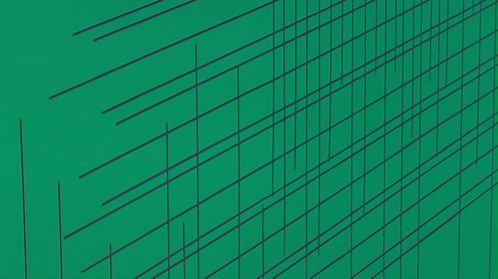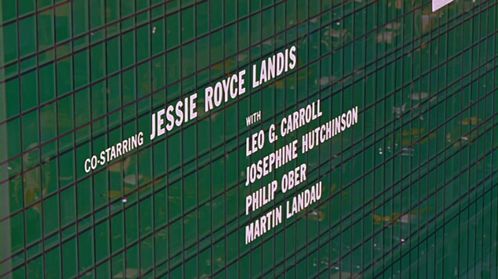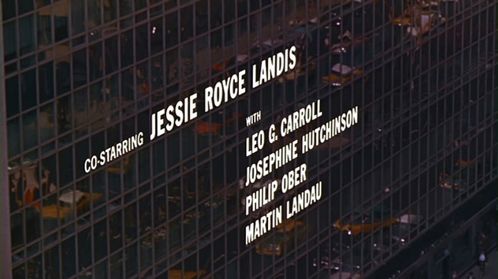Bass Resonance
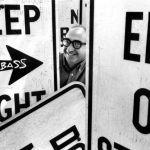
1999 e-literature award winner John Cayley writes about Saul Bass of classic film title fame. A precursor to language arts innovators Jenny Holzer, Richard Kostelanetz, and Cayley himself, Bass may now be recognized as a poet in his own 'write,' important for a new generation of designwriters creating "graphic bodies of language," moving words and signifying images, in digital environments.
Saul Bass on the set of West Side Story; Photography: Bob Willoughby⏴Marginnote gloss1⏴Brian Kim Stefans, in his November 2005 essay responding to _First Person_, “The Pixel/The Line,” suggests that moving words may be hard to square with (lower-case) literary art generally. Stefans cites reasons having to do not with textuality and authority, but meaning.
— Joseph Tabbi (Nov 2005) ↩
Was Saul Bass a writer? Was he a poet? Given that his film title ‘texts’ are not ‘his’ - not his compositions in the accepted sense, what is his art and how can it be seen as a writer’s art, a literal art? N. Katherine Hayles, an important theorist of writing in new media, suggests that the materiality of any text, emerges as a dance between the medium’s physical characteristics and the work’s signifying strategies (personal communication). Saul Bass does this dance with words. We need, says Hayles, to follow the dance when we read and write because our moves require a ‘ media specific ’ analysis of language art. The physical characteristics of the media that both deliver and constitute writing are in flux, and writers are using novel or re-emergent signifying strategies to generate their meanings as literal art.Personal email communication with John Cayley. Here is a published formulation: “The materiality of an embodied text is the interaction of its physical characteristics with its signifying strategies.” N. Katherine Hayles. My Mother Was a Computer: Digital Subjects and Literary Texts. Chicago: University of Chicago Press, 2005, p. 103 (emphasis in original). The work of Saul Bass re-emerges, and can be shown to underlie the so-called new.
Words move. The graphic bodies of language - from letters to words, from phrases to entire texts - translate, scale, and morph on our private and public screens in a bewildering and so-far uncatalogued array of transitions. As readers, we are more and more habituated to such literal dynamism, a kinetic textuality that is hard to square with capital-l Literature’s notions of the copy-text, the edition, the authorized textual event - all those institutionally published forms of words that transform the writer into a ‘person of letters’ - and, for example, allow her to generate royalties from licensing what has legal-magically become an enclosed property.
When did words begin to move? This question pulls me back - from a familiar, if utopic and theoretical, ‘new textuality’ rant - to the work of Saul Bass, to a history of practice. Written words first moved on film. Film titling, in particular, is where we must look for a self-conscious and aestheticized practice of dynamic typography and, indeed, of dynamic writing. This work predates the small body of video-based language work (Richard Kostelanetz), the few but significant essays of art language practitioners (Jenny Holtzer), and also, of course, what writing there is that exists in programmable media. Given that time-based, dynamic writing is here to stay, on screen or wherever it next migrates, its largely unacknowledged and little-analysed early history - in media that support its time-based properties - deserves far greater attention. And not only for a history of the form and its aesthetics - readers like you and I are now, for example, increasingly subject to advertising’s appropriation of ‘type in motion.’ To my mind, there has been a recent marked increase in high-end ads with sophisticated dynamic textuality. We need tools for its critical reading.
The major exposition of Saul Bass’s graphic and film title work at London’s Design Museum was, therefore, essential. Saul Bass was the first film title designer to be given a screen credit by the Director’s Guild of America (for Preminger’s Carmen Jones 1954) and remains an all but uniquely name-checkable artist in the film titles field. Yet his fame derives equally if not in greater measure from his related, more purely graphic work, where he is a central figure in that late-50s, early-60s school of jazz-rhythmic, cool, flat, monochromatic design, with a clever use of abstraction that allowed for significant interaction between normally distinct representational modes: paper cut-out silhouettes become body parts, become an assembled corpse, become (once more) a potential and actual surface for writing (see his titles for Anatomy of a Murder 1959, with the process I’ve just described encapsulated in the film’s famous posters). Many visitors to the exhibition will have gone there simply to revisit one source of a perennially hip graphic style.
Anatomy of a Murder, 1959 (Director: Otto Preminger; Design: Saul Bass; (c) AMPAS)
Nonetheless the film title work is crucial. Certain aspects of the style I’ve characterised are also vital to the dynamic writing of Bass’s most important titles. Specifically, we must try to understand the distinct ways in which Bass plays with abstraction; how they carry over from his graphic work and become, as it were, played out and dramatised in his time-based titling. Bass uses abstraction in a manner that recalls Scott McCloud’s brilliant sketch of the subject in Understanding Comics . For McCloud, the disjuncture between visual abstraction and written language is a creative problem. He suggests a continuum from the extremes of graphic abstraction to conventional signs of writing. The folk etymologies of pictorial word-signs (early letter-forms, hieroglyphics, Chinese characters) lend their evocative history to a range of suggestive procedures. Don’t get me wrong. I’m not (and neither is McCloud) a theoretical naive, or wedded to an orientalist hallucination of ideography. The disjuncture between language and graphics remains clear. The two practices are materially distinct because their signifying strategies and physical characteristics are radically different. Nonetheless, suggestive links are links, and such links may signify. They can do more than this. They can constitute a rhetoric and materiality of their own, a trans-medial art practice.
Like McCloud’s ‘invisible art,’ graphic design, particularly typographic design, is a trans-medial art par excellence, part of an engaged project which strives to make the visual and sub-linguistic aspects of writing signify. Graphic design proceeds to set out writing’s ‘paratextual’ properties - conventional and creative aspects of writing’s layout and framing - and render them not only aesthetically but substantively meaningful. How else can the performances of typography be appreciated? What need of typographers otherwise? Saul Bass, through the reality of the once-new technology of film and its illusion of animation, gave us the first literal performances of this necessary and vital interplay between language-as-visual-form and language-as-symbolic-representation. He animated the bodies of words along with their paratextual demons and familiars.
Bass achieved this during the second half of the 1950s, in his groundbreaking titles for films from The Man with the Golden Arm (1955) through Psycho (1960), and, to a certain extent, Spartacus (1960). The latter marks a distinct shift in his practice, after which, in the 1960s and 1970s, he turned away from film titling and worked more directly with the visual imaginary of cinema, as then understood. Spartacus uses photorealist images of objects - especially a bronze bust - but shot such that they hover on the edge of the silhouette-abstraction that had become a Bass trademark. From Spartacus on, the actual words of his titles are distinct typographic forms floating over or through the visual imaginary that they caption. In Spartacus, a letter-edge might still have caught on the edge of a silhouette. By contrast, none of the words in the titles for Cape Fear (1991) would share a surface with the water and shadow over which they move.
This more familiar, later work - in what has become the establish mode of film titling - sets the innovations of Bass’s 1950s work in sharp relief. The typographic ‘rule’ - typically a printed bar of ink - was an important trans-medial element in his film titles of the time. Rules are quintessentially paratextual. They share the surface of writing and they share its graphic materiality - particularly contrasting monochrome colour. They manage and marshal the spaces in which writing is set, but they are not writing in the strict sense of symbolic representation. At one and same time, rules are also lines, lines that may shape themselves into abstract visual representations.
The Man with the Golden Arm, 1955 - two versions (Director: Otto Preminger; Design: Saul Bass; (c) AMPAS)
Titles for The Man with the Golden Arm demonstrate this perfectly. A single heavy rule sweeps down to mark the director’s credit; three more are propagated and, while introducing the names of the (three) lead actors, suggest, to my eye, walking legs. Three of the four vanish leaving one upper rule, with the three now returning, sweeping in from the other screen edges, to set out the superbly composed spaces of the film’s title. The same rules go on to marshal and punctuate the remaining credits, suggesting more visual forms and spaces, and also, I would argue, letter forms, before finally and infamously combining to become the jagged silhouette of the ‘golden arm’ itself.
Rules in Bass’s work do not typically become letters, but they do interfere with the surfaces of writing - sometimes making the switch from foreground to background and becoming a newly delineated surface of inscription. This is shown, for example, if we consider the torn-out surface spaces of Bunny Lake is Missing as in some sense a special type of rule. Rules can also interfere directly with writing, which provides a reading of the titles for Psycho where they become manic and overwhelming, slicing through the caption words, momentarily allowing us to glimpse and read, before destroying legibility in a striated frenzy that is permanently linked with cinema’s most notorious shocker.
Bass’s masterpiece is the title sequence for North by Northwest (1959) where rules are present in their primary role as the squared lines supporting text. But more, in this sequence, their formation of a (archi)textual gridwork also provides a direct link to the visual imaginary, to a world of real images, a prefiguration of Bass’s personal concerns with cinema per se and also, I’d argue, an unconscious premonitory graphic representation not only of the interaction of the symbolic and the real but of the information-age virtual and the real. These titles are a ‘central processor’ of writing in new media, before its time had come.
These images of North by Northwest have been taken from notcoming.com
The sequence opens with a landscape-aspect grid receding in perspective, not yet quite recognizable as the surface of a modernist office block. Words of the titles glide in on the gridlines and, in particular, glide up and down the vertical lines where they meet and come momentarily to rest for reading. As they do so, their movements are suddenly like those of elevators in a building, giving us one of the first visual clues to a real-world referent for the abstract grid as a signifier or representation.
This resemblance of the words’ movements to elevators marks a relatively uncharacteristic evocation of Concrete poetics - bodies of words behave like objects. Words in Bass’s Goodfellas (1990) titles imitate coke-accelerated cars, but I can’t think of other prominent examples. In fact, his work is remarkable for its avoidance of Concrete. Paratextual elements, like rules, are allowed to crossover, via abstraction, into the visual, but words remain set in legibility, as tokens of the symbolic. The important thing in Bass’s titles is the continuum that is played out in literal time-based art, a continuum of rhetorical possibilities and signifying strategies that cross and recross from visual to linguistic media and back, in evocative iterative performance, without ever loosing a grip on their specific materialities.
The ruled gridlines of North by Northwest are faithful to graphics, typography, visuality, and text all at once. As the sequence progresses this becomes clear. The words of the title perform their function - we can simply read the credits - and give material pleasure in their design and movement. At a certain point the grid moves away from abstraction and is filled in with the mirrored glass windows of a modernist office block. It becomes real or rather more than real because it is a also mirror, a surface that is one particular privileged representation of the world. We see people and traffic alive and moving in the mirror-world and world of filmic naturalism. Meanwhile, the title words continue to share this same surface. They are still well-set and respectful of typographic principles but now they share a surface of visual representation that is simultaneously a real object (the building) in the (film) world. It’s a tour de force. These titles embody a continuum of signifying strategies across media that could only be performed in time.
The potential for the now familiar screenic surface of programmable media as a site of a literal trans-medial art is discovered in the titles for North by Northwest . It’s as simple and as richly suggestive as that. Where do we go from here? In his work on West Side Story (1961) Bass quietly and wittily played with real surfaces as a site for (title) writing, with the credits expressed as graffiti and intermixed with signage. One of the recognized artists in contemporary film titles, Kyle Cooper, literally etched the credits for Se7en (1995) onto film stock. Some suggestions: We continue to write with a Bass-resonant reverential materialism, with respect for the surfaces on which we make our inscriptions. We move writing from surface to surface, from media to media, with this same respect, not only from the pseudo-transparent surface of print to the screen or the virtual surfaces of artistic performance, but onto real surfaces. We do this writing in real and in human time.
*This essay has also appeared in Mute: Culture and Politics After the Net , Winter/Spring 2005 Issue 29.
Work Cited
McCloud, Scott. Understanding Comics: The Invisible Art. Kitchen Sink Press, 1993. New York: HarperPerennial, 1994.
Cite this article
Cayley, John. "Bass Resonance" Electronic Book Review, 5 November 2005, https://electronicbookreview.com/publications/bass-resonance/
